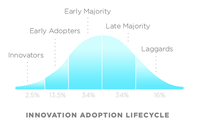Technology adoption life cycle

Imagine you're a kid who loves toys. Sometimes, your mom or dad gets you a new toy to play with. But did you know that not every kid gets the same toy at the same time? That's because everyone has different tastes and preferences, and parents might not want to spend the same amount of money on toys. This is kinda like how people adopt or buy new technology.
Let's say a company invents a new toy that's never been seen before. Maybe it's a robot that can dance and sing with you. At first, only a few people will know about it, like the workers at the toy factory and their families. They might think it's really cool, but not enough people know about it yet to make it a big success.
Then, the company starts advertising the robot toy on TV, in magazines, and on the internet. More people start hearing about it and seeing how much fun it is. Some kids might start talking about it with their friends and begging their parents to get one. This is the early adopter stage - the people who are first to try out a new toy or technology.
As more people start buying the robot toy, like your neighbor and your friend from school, more toy stores start carrying it too. The toy becomes more popular and starts showing up in more places. This is the early majority stage - when a lot of people start to buy the toy because they see how fun it is and how it can make their lives better.
Eventually, almost everyone knows about the robot toy and it's everywhere you look. Maybe you see it in every toy store, on TV commercials, and in your friends' toy collections. This is the late majority stage - when people start buying something because it's common and everyone else seems to have it.
Finally, after a while, some people start getting tired of the robot toy. Maybe they've played with it so much that it's not as exciting anymore, or maybe they've found a new toy they like better. This is the decline stage - when a technology or product starts losing popularity and people stop using or buying it.
So basically, this is how technology adoption life cycle works:
- Early stage: only a few people know about and use a new technology or product.
- Early adopter stage: people who like to try out new things start using it and talking about it.
- Early majority stage: a lot of people start using it because they see how it can make their lives better.
- Late majority stage: almost everyone starts using it because it's popular and common.
- Decline stage: people start moving on to newer and better things, and the technology or product becomes less popular.
Let's say a company invents a new toy that's never been seen before. Maybe it's a robot that can dance and sing with you. At first, only a few people will know about it, like the workers at the toy factory and their families. They might think it's really cool, but not enough people know about it yet to make it a big success.
Then, the company starts advertising the robot toy on TV, in magazines, and on the internet. More people start hearing about it and seeing how much fun it is. Some kids might start talking about it with their friends and begging their parents to get one. This is the early adopter stage - the people who are first to try out a new toy or technology.
As more people start buying the robot toy, like your neighbor and your friend from school, more toy stores start carrying it too. The toy becomes more popular and starts showing up in more places. This is the early majority stage - when a lot of people start to buy the toy because they see how fun it is and how it can make their lives better.
Eventually, almost everyone knows about the robot toy and it's everywhere you look. Maybe you see it in every toy store, on TV commercials, and in your friends' toy collections. This is the late majority stage - when people start buying something because it's common and everyone else seems to have it.
Finally, after a while, some people start getting tired of the robot toy. Maybe they've played with it so much that it's not as exciting anymore, or maybe they've found a new toy they like better. This is the decline stage - when a technology or product starts losing popularity and people stop using or buying it.
So basically, this is how technology adoption life cycle works:
- Early stage: only a few people know about and use a new technology or product.
- Early adopter stage: people who like to try out new things start using it and talking about it.
- Early majority stage: a lot of people start using it because they see how it can make their lives better.
- Late majority stage: almost everyone starts using it because it's popular and common.
- Decline stage: people start moving on to newer and better things, and the technology or product becomes less popular.
Related topics others have asked about:
